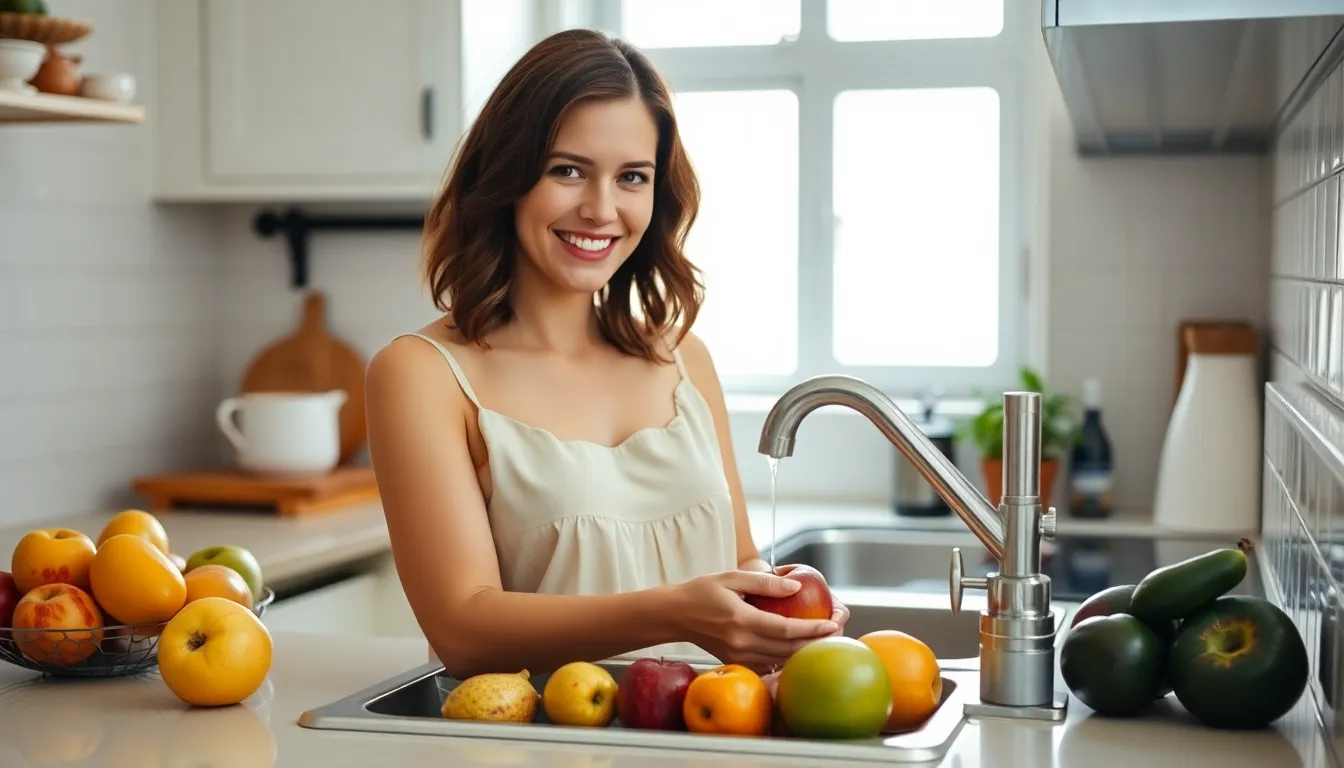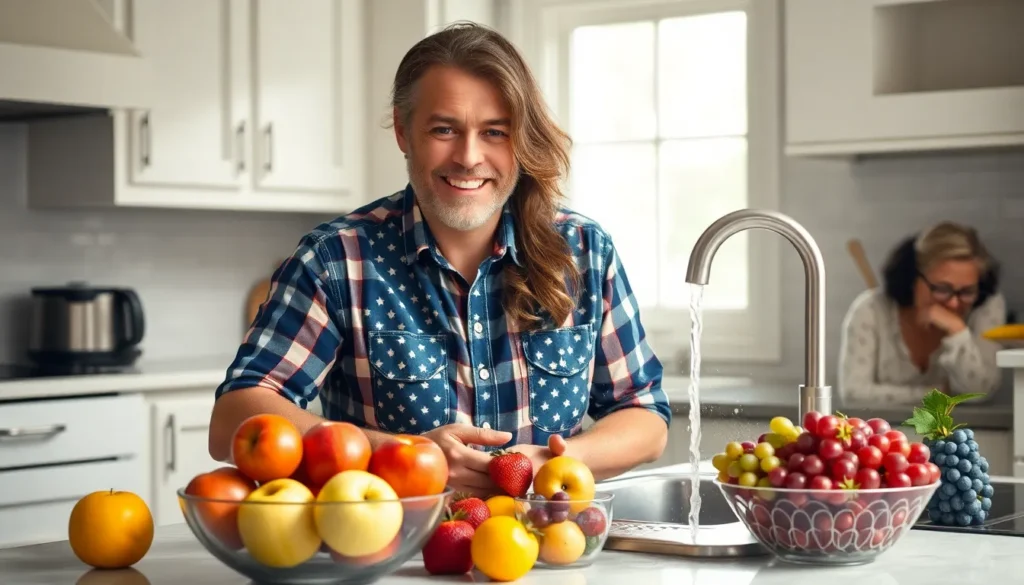Table of Contents
ToggleWhen it comes to enjoying fresh fruit, a little extra care goes a long way. Sure, that shiny apple looks tempting, but what’s lurking beneath that surface? It’s time to tackle the age-old question: what should you wash your fruit with? Spoiler alert: it’s not just water, and you might want to ditch that soap!
Understanding Why Washing Fruit Is Important
Washing fruit ensures the removal of dirt, pesticides, and harmful bacteria. Contaminated fruit can lead to foodborne illnesses. Research shows that around 48 million people in the U.S. become sick from foodborne diseases annually, highlighting the necessity of washing produce.
Many fruits can harbor pathogens like E. coli and Salmonella. By thoroughly washing fruit, consumers reduce the risk of ingesting these harmful microorganisms. Fruits also accumulate residues from agricultural practices, including pesticides and wax coatings. These substances can interfere with health when consumed.
Proper washing techniques improve overall food safety. Scrubbing firm fruits such as apples and pears under running water helps dislodge contaminants. Soaking berries in a solution may also remove residual dirt and chemicals without damaging the delicate surface.
Additionally, washing fruits aids in enhancing their taste and texture. Dirt and residues can create an unpleasant experience while eating. For optimal results, rinsing fruits before consumption preserves their freshness.
Water alone often suffices for cleaning, but some fruits benefit from additional washing solutions. Vinegar and baking soda can help remove stubborn residues. Choosing the right method plays a crucial role in making fruits safe and enjoyable to eat.
Focusing on proper washing practices assures families that the fruits on their plates are free from unwanted contaminants. Understanding the importance of washing fruit cultivates healthier eating habits and promotes overall well-being.
Common Methods for Washing Fruit

Effective methods for washing fruit enhance food safety. Two primary techniques are water washing and specialized fruit wash solutions.
Water Washing
Using running water is a fundamental method for washing most fruits. Firm fruits, such as apples and pears, benefit from scrubbing under a stream of water. This action helps remove dirt and pesticides effectively. Several fruits, like grapes and cherries, require thorough rinsing to eliminate surface contaminants. It’s vital to use clean, cold water to ensure optimal results. Avoid using soap, as it can leave harmful residues on the fruit. Thus, water washing serves as a reliable first step for many varieties.
Fruit Wash Solutions
Fruit wash solutions provide additional cleaning power for certain fruits. A vinegar-water solution, typically consisting of one part vinegar to three parts water, effectively eliminates bacteria and pesticides on produce. Baking soda also proves effective; a mixture with water can remove residue on tougher surfaces. Soaking fruits, such as berries, in these solutions for several minutes enhances cleaning. Rinse thoroughly afterward to remove any residual solution. Utilizing these specialized washes adds an extra layer of safety when consuming fresh fruit.
Natural Alternatives for Washing Fruit
Natural alternatives offer effective options for washing fruit, enhancing safety while avoiding harmful additives.
Vinegar and Water
Vinegar mixed with water serves as a potent cleaning solution for fruit. A typical ratio is one part vinegar to three parts water. Soaking fruits like apples and strawberries in this solution for five to ten minutes can help remove residues and bacteria. Afterward, it’s crucial to rinse the fruits thoroughly under running water to eliminate any vinegar taste. Research indicates that vinegar may reduce pesticide residues by up to 98 percent on certain fruits. Many people prefer this method for its accessibility and effectiveness.
Baking Soda
Baking soda provides another powerful option for washing fruit. A common practice involves mixing one teaspoon of baking soda with two cups of water. Soaking firm fruits, such as peaches and cucumbers, in this solution for about 12 to 15 minutes can effectively clean their surfaces. Studies show that baking soda can neutralize a range of pesticide residues, offering a safe approach to cleaning. After soaking, a thorough rinse under running water is essential. This process not only enhances safety but also helps improve the taste and freshness of the fruit.
Commercial Fruit Wash Products
Commercial fruit wash products offer specialized solutions for cleaning fresh produce. These products typically contain ingredients designed to remove pesticides and contaminants effectively.
Types of Products Available
Many options exist in the market. Commercial washes include liquid concentrates and ready-to-use sprays. Liquid concentrates often require dilution with water, allowing for customized cleaning strengths. Ready-to-use sprays provide convenience, enabling quick application directly on fruits. Additionally, some washes utilize natural ingredients like citric acid or enzymes for effective cleaning without synthetic chemicals. Brands emphasize organic formulations, appealing to health-conscious consumers.
Effectiveness Comparison
Effectiveness varies among different commercial fruit wash products. Research shows many product formulations can significantly reduce pesticide residues and bacteria. Some studies indicate that specialized washes outperform plain water by removing up to 90 percent of contaminants. However, not all products maintain the same efficacy across various fruit types. Testing indicates that certain commercial washes may provide better results on firm fruits like apples than on delicate berries. Users should consider product labeling for ingredient transparency and the intended use for optimal results.
Tips for Properly Washing Fruit
Selecting the right method for washing fruit impacts safety and taste. Cold running water serves as the primary rinsing choice for firm fruits like apples and pears. Using a soft brush may enhance cleaning for fruits with thicker skins, ensuring removal of dirt and residues. Scrubbing firm fruits under water effectively dislodges contaminants.
Soaking delicate berries, such as strawberries and raspberries, in a vinegar-water solution helps remove pesticides. A recommended ratio is one part vinegar to three parts water. Allowing these fruits to soak for five to ten minutes increases cleaning efficiency. Thorough rinsing under cold running water afterward completes the process.
Baking soda presents another effective washing option. Mixing one teaspoon of baking soda in two cups of water allows fruits like peaches and cucumbers to soak for 12 to 15 minutes, breaking down pesticide residues. Residual baking soda necessitates rinsing under running water to ensure complete removal.
Commercial fruit washes provide specialized solutions for cleaning fruits and vegetables. Many products contain natural ingredients like citric acid or enzymes to help reduce contaminants. Reading product labels offers insight into ingredient transparency and effectiveness for different fruit types.
Finally, consider prioritizing methods that research supports. Studies indicate vinegar may remove up to 98 percent of pesticide residues on certain fruits. Baking soda can neutralize various residues as well. Following these tips promotes healthier eating habits and enhances overall well-being.
Properly washing fruit is vital for ensuring safety and enhancing flavor. By employing effective techniques and solutions, individuals can significantly reduce the risk of harmful bacteria and pesticide residues. Whether opting for a simple rinse under cold running water or utilizing natural alternatives like vinegar and baking soda, each method offers unique benefits.
Commercial fruit washes also provide convenient options for those looking for added assurance in cleaning their produce. Ultimately, making informed choices about how to wash fruit can lead to healthier eating habits and a more enjoyable dining experience. Prioritizing these practices not only promotes well-being but also cultivates a deeper appreciation for fresh fruits.







